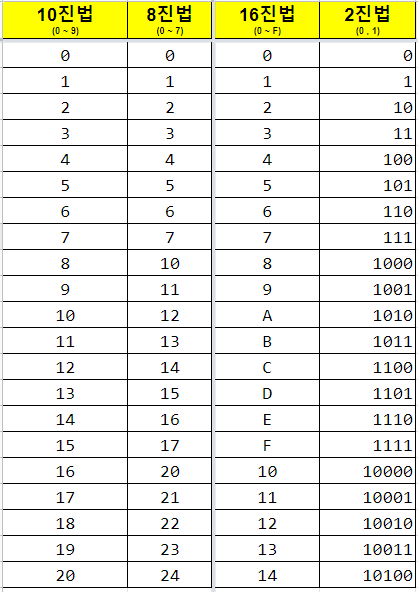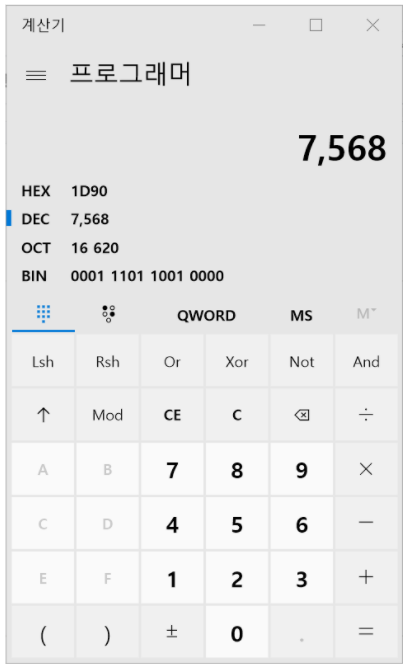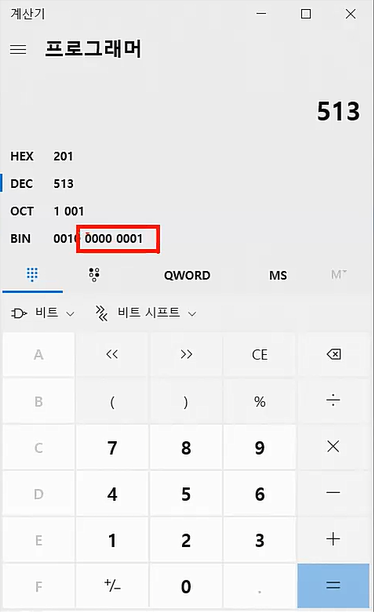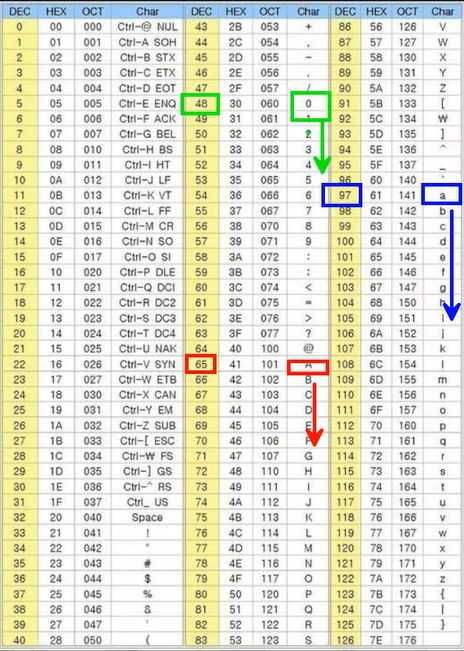1. 자바의 기본 자료형(Primitive Data Type) -> 데이터 타입 심플!
총 8개
- 정수 타입: byte(1바이트), short(2바이트), int(4바이트), long(8바이트)
- 실수 타입: float(4바이트), double(8바이트)
- 문자 타입: char(2바이트)
- 논리 타입: boolean(1바이트)

**Primitivate Type - 기본타입 vs Reference Type (Objective Type) - 참조타입
byte 클래스 타입 (ex: Scanner, String)
short
int 배열 타입
long
float enum 타입
double
char 인터페이스
boolean + new 를 통해 생성되는 것들
-> reference 타입 변수는 ‘주소값’을 담고 있고 이는 4 byte 입니다. (32bit JVM 인 경우)2. 진법 & 용량
(1) 진법
- 표현하는 기호가 10개인 숫자체계 : 10진법
- 기타 진법의 예 : 12진법(1년의 달, 12간지 등)
[진법 변환 연습]

(2) 용량
- 용량 : 더 많은 숫자의 범위를 표현할 수 있다!
- 10진법 4자리의 경우 : 0000 ~ 9999 ( 10의 4제곱 = 10000 개 표현 가능)
- 8진법 3자리의 경우 : 000 ~ 777 ( 8의 3제곱 = 512 개 표현 가능)
- 16진법 5자리의 경우 : 00000 ~ FFFFF ( 16의 5제곱 = 65536 개 표현 가능)
- 2진법 8자리의 경우 : 00000000 ~ 11111111 ( 2의 8제곱 = 256 개 표현 가능)
컴퓨터의 기본 용량 Byte 란
-
2진수 8자리를 컴퓨터의 최소한의 용량으로 정의
-
2진수 체제로 기억하고 연산하고, 저장하는 컴퓨터는 2진법 한자리를 1 bit 라 하고 가장 기본적인 데이터 단위로
-
2진수 8자리 즉 8 BIT 를 1 byte 란 단위를 붙여서 운영
1 Byte = 8 bit -> 2^8ex. 2 Byte -> 2^16
1 Byte의 크기?
-
1 Byte → 2의 8제곱만큼의 공간 (256가지 숫자 표현 가능)
0 ~ 255 (10진법) 0000 0000 ~ 1111 1111 (2진법 표기) 00 ~ FF (16진법 표기) -
2진법과 16진법은 대응됨
2^4 = 16 (즉, 2진법 4글자가 16진법 1글자)
프로그래머는 2진법과 16진법을 ♥♥한다
- 2진법 4자리는 16진법 1자리
16진법 자리수만 보면 몇 byte 용량인지 보임 - 2진법 8자리 → 1Byte
- 16진법 2자리 → 1Byte
Byte 단위
1 Byte = 8 Bit
1024 Byte = 1 KByte (kilo byte)
1024 KByte = 1 MByte (mega byte)
1024 MByte = 1 GByte (giga byte)
1024 GByte = 1 TByte (tera byte)
Peta , Exa, Zetta, Yotta ….
진법 (영어)
10진법 : Decimal notation
2진법 : Binary notation
8진법 : Octal notation
16진법 : Hexadecimal notation
진법 계산기 활용하기
- 윈도우스 등에 내장되어 있는 계산기를 활용 가능

2. 기본타입간의 자동 형변환 (Implicit Casting)
** 기본적으로
- 작은 크기 에서 → 큰 크기의 자료형으로는 자동형변환
- 정수타입 에서 → 실수 타입으로 자동형변환

[정수타입 변수 코드]
package com.lec.java.variable03;
public class Variable03Main {
public static void main(String[] args) {
System.out.println("정수 타입 변수");
// byte : 8bit , 256가지 표현 가능한 용량. -128 ~ +127
System.out.println("byte: " + Byte.MIN_VALUE + " ~ " + Byte.MAX_VALUE);
byte num1 = -128; // (대입연산자가) 4byte int 타입이었던 128을 byte로 변환 (자동현변환)
byte num2 = 0;
byte num3 = 123;
// byte num4 = 128; // 에러: byte가 저장할 수 있는 값의 범위를 넘어간 값 대입.
// Type mismatch: cannot convert from int to byte (형변환이 안된 것. 즉 int->byte로 자동현변환 불가)
// 에러 인식 순서 : 1. literal 인식 2. 대입연산자를 통한 형변환 가능 여부 확인
// short : 2byte, 16bit, 65536가지 표현 가능한 용량. -32768 ~ 32767
System.out.println("short: " + Short.MIN_VALUE + " ~ " + Short.MAX_VALUE);
short num5 = -12345;
short num6 = 12345;
// short num7 = 32768;
// short num8 = -32769;
// int: 4byte 32bit, -2147483648 ~ 2147483647
// long: 8byte 64bit, -9223372036854775808 ~ 9223372036854775807
System.out.println("int: " + Integer.MIN_VALUE + " ~ " + Integer.MAX_VALUE);
System.out.println("long: " + Long.MIN_VALUE + " ~ " + Long.MAX_VALUE);
// int num9 = 9876543210; // The literal 9876543210 of type int is out of range (애시당초 literal을 인식하는데 문제)
// long num10 = 9876543210; // 으잉? The literal 9876543210 of type int is out of range -> int 타입으로 리터럴 인식하려는데 범위를 벗어났다는 의미
// 에러 인식 순서 : 1. literal 인식 2. 대입연산자를 통한 형변환 가능 여부 확인
// 리터럴(literal) : 코드에 직접 입력하는 값.
// 리터럴도 타입이 있다.
// 정수타입리터럴은 int 타입으로 인식하려 한다.
// 실수타입리터럴은 double 타입으로 인식하려 한다.
long num11 = 9876543210L;
// 9876543210 이라는 숫자가 int 타입이 아니라 long 타입임을 명시하기 위해서
// 숫자 뒤에 영문자 L을 붙여줌
// 자바에서 정수 타입 변수의 기본은 int임.
// 자바는 정수 숫자(리터럴)를 별도 표기 가 없으면 int라고 생각.
// 자바는 원래 동일한 타입만 대입 가능.
long num12 = 12; // 12 라는 int 를 long 타입에 저장
long num13 = 12L; // 12 라는 long 를 long 타입에 저장
int num14 = 12;
// 진법에 따른 정수 리터럴 표기
int number1 = 11; // 10진수(decimal)
int number2 = 0xB; // 16진수(hexadecimal) : 보통 0x로 시작
int number3 = 013; // 8진수(octal) : 0으로 시작
int number4 = 0b1011; // 2진수(binary) : 0b로 시작
System.out.println("number1 = " + number1);
System.out.println("number2 = " + number2);
System.out.println("number3 = " + number3);
System.out.println("number4 = " + number4);
}
}[실수타입 변수 코드]
package com.lec.java.variable04;
public class Variable04Main {
public static void main(String[] args) {
System.out.println("실수 타입");
// 실수타입
// float(4byte)
// double(8byte)
double number1 = 3.14;
// float number2 = 3.14; -> cannot convert 에러
// 별도의 표기가 없는 경우 소수점이 있는 리터럴은 double로 인식
// 3.14는 double형. 이것을 작은 자료 타입인 float에 저장할 수 없다.
float number3 = 3.14f;
// 실수리터럴 뒤에 f를 붙여주면 float 리터럴로 인식된다.
// 실수타입에서 최소, 최대값
System.out.println("float: " + Float.MIN_VALUE + " ~ " + Float.MAX_VALUE);
System.out.println("double: " + Double.MIN_VALUE + " ~ " + Double.MAX_VALUE);
// 실수에서 말하는 최소값의 의미는 0~1 사이에서 얼마나 소수점 이하로 디테일하게 표현할 수 있는가
// 최대값의 의미는 1이상의 값에서 얼마만큼 많은 숫자를 정밀하게 표현할 수 있는가
// 따라서, 컴퓨에서 실수연산은 100% 정확하지 않다! 그래서 얼마나 정밀하게 표현할 수 있느냐가 실수타입의 의미
float number4 = 1.23456789f;
double number5 = 1.23456789;
// 기본적으로 float은 소숫점 6자리 정도까지만 정확하게 표현함
System.out.println("number4 = " + number4);
System.out.println("number5 = " + number5);
// float과 double은 저장할 수 있는 값의 크기만이 아니라
// 소수점 이하 정밀도(precision)에서도 차이가 있다. 나머지는 근사값으로 표현
// 실수표기법
double number6 = 123;
double number7 = 1.23e2;
System.out.println(number6);
System.out.println(number7);
// 위의 2개 결과 모두 : 123.0
}
}[char, boolean, String 타입 변수 코드]
package com.lec.java.variable05;
public class Variable05Main {
public static void main(String[] args) {
System.out.println("변수 : char, boolean, String");
// char: 문자 하나를 저장하기 위한 자료 타입(2바이트)
// char 는 문자의 코드값(정수)가 담긴다 (2byte)
char ch1 = 'A';
// 문자열(String)은 큰따옴표("")로 묶어 줌. (String literal)
// 문자 하나(char)는 작은따옴표('')로 묶어 줌. (char literal)
// char ch2 = "A";
System.out.println("ch1: " + ch1);
char ch2 = '한';
char ch3 = '글';
System.out.println("ch2: " + ch2);
System.out.println("ch3: " + ch3);
char ch4 = 0xAE01; //16진수 2자리 -> 2 byte
System.out.println("ch4: " + ch4);
char ch5 = 1234;
System.out.println("ch5: " + ch5);
char ch6 = '!';
char ch7 = 33;
System.out.println("ch6: " + ch6);
System.out.println("ch7: " + ch7);
System.out.println("ch7: " + (int)ch7);
// 1. "bible"
// 2. "cable"
// 3. "able"
// 오름차순 정렬하면?
// 3 > 1 > 2
// 1. "aaAA"
// 2. "AaAa"
// 3. "aAaA"
// 4. "AAaa"
// 4 > 2 > 3 > 1
char ch8 = 'A';
char ch9 = 'a';
System.out.println("'A' : " + (int)ch8); // 65
System.out.println("'A' : " + (int)ch9); // 97
// boolean (논리형) : 참(true), 거짓(false) , 용량 1byte
boolean b1 = true;
boolean b2 = false;
System.out.println("b1: " + b1);
System.out.println("b2: " + b2);
System.out.println(10 < 20);
System.out.println(10 > 20);
boolean b3 = 10 <20;
System.out.println("b3: " + b3);
// String 타입 (문자열) - 객체
// ※ String은 primitive 타입은 아닙니다
String name = "Hong";
String nick = "thunder";
System.out.println("이름은: " + name + "\n별명은:" + nick);
}
}3. 암묵적 형변환 (Implicit Casting)
- 암묵적 형변환(Implicit casting): 자바 언어가 자동으로 해주는 형변환
- primitive type 에서 implicit casting 방향

- 명시적 형변환(Explicit casting): 프로그래머가 직접 타입을 변환하는 것
- (변환하고자 하는 타입명)변수/값
public class CastingMain {
public static void main(String[] args) {
System.out.println("형변환(Casting)");
// 암묵적 형변환
byte num1 = 123; // byte <- int
short s1 = 123; // short <- int
int n1 = s1; // int <- short
char ch1 = 'A';
//s1 = ch1; // char -> short 불가능
n1 = ch1; // int <- char
// 명시적 형변환
byte num5 = (byte)513; // 4byte 에서 상위 3byte 를 잘라내어 byte 변환
System.out.println("num5 = " + num5); // 1 출력 - 주의! (상위 바이트가 사라자기 때문) 자료손실 발생할 수 있다!
byte num6 = 10;
int n2 = 10;
// byte num7 = n2; // int '변수' -> byte 는 implicit casting 안됨. (비록 용량 범위 안이 숫자라 하더라도)
byte num7 = (byte)n2;
🎇TIPs!
- 프로그래밍을 잘 학습할 수 있는 법 : 프로젝트 진행, 타인에게 표현 및 설명하기(블로그)
- ASCII 코드 : https://blog.sweetchip.kr/271 (참조사이트)

